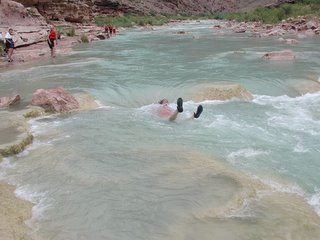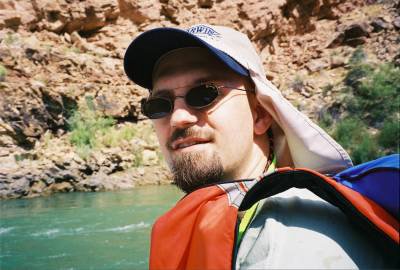Grand Canyon: Travertine Exposes Creationist Travesty

Travertine. What is it? Basically, it's calcium carbonate CaCO3, the same stuff which makes up stalactites and stalagmites in caves. But unlike either of those, travertine forms exclusively in the beds of rivers, streams, and springs. It contains traces of biological and mineral deposits which often give it interesting patterns and colors, making it an ideal rock for exotic jewelry. On the third day of the NCSE's rafting trip through the Canyon this summer, we trekked up the Little Colorado river to jump into the warm, mild rapids and let them suck us through and spit us out. That was FUN! In the photo, you can see Eugenie Scott being pulled through, feet-first. Better than a rollercoaster. But in the warmer water of the Little Colorado, we could see travertine actually forming along the river's bottom. In fact, it's the travertine which makes the turquoise color of the river in the picture.
Travertine is also found in many places along the walls of the Grand Canyon -- above the line of the Great Unconformity.
That's right, folks deposits of rivers, located right in the middle of sediments which creationists maintain were laid down during Noah's flood.
Many times before we'd even reached the Little Colorado, our boatmen pointed out areas in the Canyon walls where large, white blotches were clearly visible. "There's more travertine over there," they would say.
Now, how did this travertine get there? Did the Great Flood get put on hold, while Noah put the Ark in a designated parking spot, allowing the layers of the canyon, mid-way along in their deposition, to erode into rivers, which cut paths allowing deposits of travertine to form several dozen yards deep, after which the flood resumed it's normal globe-covering wateriness? Of course not! The very idea is absurd, both from a scientific and a theological viewpoint. No, these travertine deposits got there because many different geologic events went into the Grand Canyon. Sometimes, the environment was covered with water. Other times, it was bone-dry, and the erosion of rain formed thousand-year-old rivers with travertine forming in them. Other times, as we have already seen, the environment was an outright desert. And yet other times still, it's true, the occasional flood passed by. But none of the many floods which helped make the Grand Canyon what it is today was Noah's flood. And it really did take millions of years as a fact of geologic history.
Eric


0 Comments:
Post a Comment
<< Home